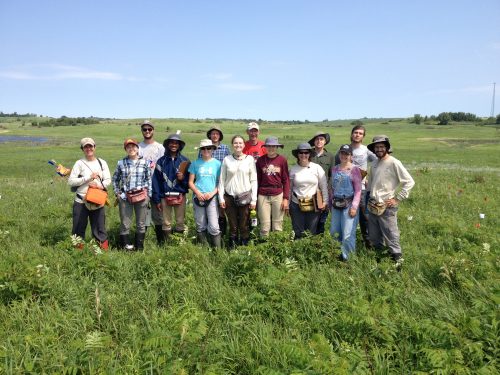It’s time to recap everything that’s been going on with the Echinacea Project for the last 12(ish) months – and trust me, it’s a lot! We report all of this info annually to our two major grant providers, CBG & UMN. This includes all of our lab and field activity.
Last spring the lab was busy as always. Led by Tracie, volunteer citizen scientists at the Chicago Botanic Garden finished cleaning heads harvested in summer 2016 and began cleaning heads harvested in 2017. These volunteers clean heads to remove all the achenes, which are then counted to give us an accurate metric of echinacea plant fitness. There were a lot of heads from 2017, and volunteers continued to clean them through the summer
A bunch of undergraduate students have worked on projects in the lab this past year, including Emily, Emma, Leah, Julie (joining Team Echinacea 2019!), Tris, Sarah, and Evan. It’s always great to have undergrads in the lab – they learn a lot from us, and we learn a lot from them! Of course, graduate students were hard at work as well. Lea not only analyzed her data regarding seed set in Liatris and Solidago, but also set up a whole new experimental plot in California. Kristen, along with volunteer Mike Humphrey, is making a collection from the hundreds of bees she caught this summer in her yellow pan traps and emergence tents.
[STUART – add something here about papers that have been written/ are currently being reviewed by journals?]
Now on to the big part of this report – our super-productive 2018 field season! The 2018 summer team (pictured) included three undergraduate students from Minnesota Colleges (Andy, Brigid, and Riley), three undergraduates in the Ison Lab at the College of Wooster (Evan, Mia, and Zeke), two high-school students (Anna and Morgan), one high-school teacher (John), one graduate student (Kristen), two recent college grads (Michael and Will), and, of course, Stuart. Gretel and Amy also came to the field intermittently throughout the summer.
We summarized the progress we made on many summer projects this past year and made flog posts about the ones where considerable new progress was made. You’ll notice this part may look remarkably similar to previous years – we’ve been conducting many of these experiments for many years!
As always, we measured survival, growth, phenology, and flowering effort of our model plant, Echinacea angustifolia, in several experimental plots. The earliest was established in 1996 and the most recent in 2015. For many of these experiments it was business as usual, and if you’re interested in learning more about them we’ve linked to their background pages below. We spent quite a bit of time measuring plants in the qGen2 & qGen3 plot (exPt 8), and while many of the plants are doing well, we had almost 50% mortality from 2017 to now. In Amy Dykstra’s experiments, we continued to monitor plant survival and growth. While mortality is low, there are still no flowering plants!
- Inbreeding experiment–INB1
- Inbreeding experiment–INB2
- Heritabiliy of fitness–qGen1
- Heritabiliy of fitness–qGen2&qGen3
- Dykstra’s local adaptation
- Ridley’s next generation rescue
- Common garden experiment–1999 cohort
- Dykstra’s interpopulation crosses
- Flowering phenology in experimental plots
- Heritability of flowering time
Otherwise, here are new 2018 update flog posts about new data in the experiments that take place in our common garden experiments. Michael is currently working on a manuscript about the effects of pollen limitation in echinacea:
In addition to out common gardens, we make observations of Echinacea plants in natural prairie remnants in our study area. These observations include flowering phenology, survival, reproduction, and incidence of disease. Amy is currently investigating remnant flowering phenology for her PhD.
- Reproductive fitness in remnants
- Demographic census in remnants
- Seedling establishment
- Flowering phenology in remnants
- Fire & fitness of EA
Echinacea angustifolia interacts with and shares space with many plant and insect species. Here are updates and flog posts about projects on species that are echinacea-adjacent. Kristen is using the data collected about pollinators on roadsides and ground nesting bees for her Master’s thesis. Andy found this year that aphids have virtually no effect on the fitness of echinacea plants. While no one this year is specifically looking at Hesperostipa, its worth noting that we did go out and check! We found only a few seeds, but collected them anyway.
- Richardson’s Liatris and Solidago phenology
- Cirsium hillii fire & fitness
- Pollinators on roadsides
- Aphid addition and exclusion
- Hesperostipa common garden experiment
Also, we have some new projects that don’t necessarily fit into any of the above categories. Here are updates of their projects.
- Pollen to seed – Mia
- Pollinators influencing male and female fitness a.k.a The Big Event – Jennifer
- Bees remove and deposit pollen – Zeke and Evan
- West Central Area experimental plots – John
And finally, we are worried about non-native Echinacea plants that are used in restorations and how they impact populations of the native Echinacea angustifolia. We have several ongoing experiments that investigate a population of Echinacea pallida introduced within our study area. Riley used the plants in P7 to gather data for his senior thesis at Gustavus Adolphus College.
- Hybrid Experiment–exPt6
- Hybrid Experiment–exPt7
- Hybrid Experiment–exPt9
- Echinacea pallida flowering phenology

Team Echinacea 2018 at exPt2. From left to right: Gretel, Amy, Will, Evan, Morgan, Zeke, Mia, John, Anna, Kristen, Andy, Brigid, Riley, Michael (Stuart took the photo)

Leave a Reply